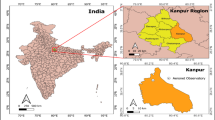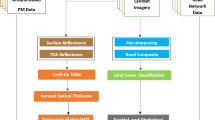Abstract
The surge in urbanization and industrialization is majorly contributing to ambient air pollution, predominantly in terms of particulate emissions. Human health is highly susceptible to the particles suspended in the air due to their lightweight and small size (≤ 2.5 μm), called atmospheric aerosols. In India, insufficient ground-based instruments hinder continuous aerosol monitoring. However, remote sensing offers earth imagery for in-depth analysis of air quality and weather parameters. In the present study, an attempt is made to retrieve the high-resolution (30 m) AOT using Landsat 8 Operational Land Imager (L8-OLI) imagery for Pune, Maharashtra, from the years 2014 to 2021. For the atmospheric corrections and better spatiotemporal resolution, the dark target spectrum-based Image Corrections for Atmospheric Effects (iCOR) algorithm was executed. The year 2021 showed the highest mean AOT value at the Pashan location (18.537° N, 73.805° E) in Pune, India. Also, seasonal analysis (winter and summer) indicates that the mean AOT in the winter gradually increases every year. The AOT retrieved using L8-OLI with iCOR and AOT retrieved from Aerosol Robotic Network (AERONET) in situ monitoring station (± 30 min) at 440 nm showed R2 = 0.76, r = 0.83, and RMSE = 0.1012. From this, it is summarized that for L8-OLI images, the iCOR algorithm performs well for the atmospheric correction by retrieving AOT at high spatial resolution with minimum cloud cover.







Similar content being viewed by others
Data availability
All data used are included in the published article.
Abbreviations
- ACIX:
-
Atmospheric Correction Inter-comparison eXercise
- AERONET:
-
Aerosol Robotic Network
- AOT:
-
Aerosol Optical Thickness
- BoA:
-
Bottom of the Atmosphere
- CC:
-
Cloud Cover
- CFMask:
-
C Function of Mask
- DB:
-
Deep Blue
- DDV:
-
Dense Dark Vegetation
- DEM:
-
Digital Elevation Model
- DSF:
-
Dark Spectrum Fitting
- DT:
-
Dark Target
- ESA:
-
European Space Agency
- i.e.:
-
That is
- iCOR :
-
Image Corrections for Atmospheric Effects
- IDW:
-
Inverse Distance Weighted
- L8-OLI:
-
Landsat 8 Operational Land Imager
- LaSRC:
-
Land Surface Reflectance Code
- LibRadtran:
-
Library for Radiative Transfer
- LUT:
-
Look-Up-Table
- MACCS:
-
Multi-Sensor Atmospheric Correction and Cloud Screening
- MAJA:
-
MACCS-ATCOR Joint Algorithm
- MEIT:
-
Multiparameter Endmember Inversion Technique
- MODTRAN5:
-
Moderate-Resolution Atmospheric Radiance and Transmittance Model–Version 5
- NASA:
-
National Aeronautics and Space Administration
- NOAA:
-
National Oceanic and Atmospheric Administration
- RMSE:
-
Root Mean Squared Error
- SIMEC:
-
SIMilarity Environmental Correction
- TIRS:
-
Thermal Infrared Sensor
- ToA:
-
Top of the Atmosphere
- USGS:
-
United States Geological Survey
References
Aldabash M, Balcik FB, Glantz P (2020) Validation of MODIS C6.1 and MERRA-2 AOD using AERONET observations: a comparative study over Turkey. Atmosphere (Basel) 11. https://doi.org/10.3390/ATMOS11090905
Andreae MO, Rosenfeld D (2008) Aerosol-cloud-precipitation interactions. Part 1. The nature and sources of cloud-active aerosols. Earth Sci Rev 89. https://doi.org/10.1016/j.earscirev.2008.03.001
Basith A, Nuha MU, Prastyani R, Winarso G (2019) Aerosol optical depth (AOD) retrieval for atmospheric correction in Landsat-8 imagery using second simulation of a satellite signal in the solar spectrum-vector (6SV). Commun Sci Technol 4. https://doi.org/10.21924/cst.4.2.2019.122
Bilal M, Qiu Z (2018) Aerosol retrievals over bright urban surfaces using Landsat 8 images. In: International Geoscience and Remote Sensing Symposium (IGARSS), IEEE Xplore
Bui QT, Jamet C, Vantrepotte V et al (2022) Evaluation of Sentinel-2/MSI atmospheric correction algorithms over two contrasted French coastal waters. Remote Sens (Basel) 14. https://doi.org/10.3390/rs14051099
Chen H, Fan X, Xia X (2018) Review of satellite remote sensing of atmospheric aerosols and its applications in climate and environment studies. Chinese J Atmos Sci 42. https://doi.org/10.3878/j.issn.1006-9895.1801.17272
Cirino GG, Souza RAF, Adams DK, Artaxo P (2014) The effect of atmospheric aerosol particles and clouds on net ecosystem exchange in the Amazon. Atmos Chem Phys 14. https://doi.org/10.5194/acp-14-6523-2014
David LM, Ravishankara AR, Kodros JK et al (2018) Aerosol optical depth over India. J Geophys Res: Atmos 123. https://doi.org/10.1002/2017JD027719
De Keukelaere L, Sterckx S, Adriaensen S et al (2018) Atmospheric correction of Landsat-8/OLI and Sentinel-2/MSI data using iCOR algorithm: validation for coastal and inland waters. Eur J Remote Sens 51. https://doi.org/10.1080/22797254.2018.1457937
Doxani G, Vermote E, Roger JC et al (2018) Atmospheric correction inter-comparison exercise. Remote Sens (Basel) 10. https://doi.org/10.3390/rs10020352
Ebi KL, McGregor G (2008) Climate change, tropospheric ozone and particulate matter, and health impacts. Environ Health Perspect 116:1449–1455. https://doi.org/10.1289/ehp.11463
Geogdzhayev IV, Mishchenko MI (2015) Validation of long-term global aerosol climatology project optical thickness retrievals using AERONET and MODIS data. Remote Sens (Basel) 7. https://doi.org/10.3390/rs71012588
Gitahi J, Hahn M (2020) High-resolution urban aerosol monitoring using Sentinel -2 satellite images. E3S Web of Conferences 171. EDP Sciences, 2023
Guo S, Hu M, Zamora ML et al (2014) Elucidating severe urban haze formation in China. Proc Natl Acad Sci USA 111. https://doi.org/10.1073/pnas.1419604111
Hadjimitsis DG (2009) Aerosol optical thickness (AOT) retrieval over land using satellite image-based algorithm. Air Qual Atmos Health 2. https://doi.org/10.1007/s11869-009-0036-0
Han M, Jia S, Zhang C (2022) Estimation of high-resolution PM2.5 concentrations based on gap-filling aerosol optical depth using gradient boosting model. Air Qual Atmos Health 15. https://doi.org/10.1007/s11869-021-01149-w
He Y, Sun L, Sun Z, Hu X (2021) Modis aerosol optical thickness product algorithm verification and analysis. Aerosol Air Qual Res 21. https://doi.org/10.4209/AAQR.210019
Jia C, Sun L, Chen Y et al (2020) Inversion of aerosol optical depth for Landsat 8 OLI data using deep belief network. Yaogan Xuebao/J Remote Sens 24. https://doi.org/10.11834/jrs.20200048
Jin Y, Hao Z, Chen J et al (2021) Retrieval of urban aerosol optical depth from Landsat 8 OLI in Nanjing, China. Remote Sens (Basel) 13. https://doi.org/10.3390/rs13030415
Jin Y, Hao Z, Huang H et al (2022) Evaluation of LaSRC aerosol optical depth from Landsat-8 and Sentinel-2 in Guangdong-Hong Kong-Macao greater bay area. China Atmos Environ 280:119128. https://doi.org/10.1016/J.ATMOSENV.2022.119128
Kganyago M, Ovakoglou G, Mhangara P et al (2020) Validation of atmospheric correction approaches for Sentinel-2 under partly-cloudy conditions in an African agricultural landscape. https://doi.org/10.1117/12.257293
Kumar V, Mehta M (2023) Investigating the applicability of a simple iterative approach for aerosol optical depth (AOD) retrieval over diverse land surface types from Landsat 8 and Sentinel 2 using visible and near-infrared (VNIR) spectral bands. Atmos Environ 314. https://doi.org/10.1016/j.atmosenv.2023.120082
Li Z, Roy DP, Zhang ZK et al (2019) Remote sensing Evaluation of Landsat-8 and Sentinel-2A aerosol optical depth retrievals across Chinese cities and implications for medium spatial resolution urban aerosol monitoring. Remote Sensing (MDPI). https://doi.org/10.3390/rs11020122
Lin H, Li S, Xing J et al (2021a) Fusing retrievals of high resolution aerosol optical depth from landsat-8 and sentinel-2 observations over urban areas. Remote Sens (Basel) 13. https://doi.org/10.3390/rs13204140
Lin H, Li S, Xing J et al (2021b) High resolution aerosol optical depth retrieval over urban areas from Landsat-8 OLI images. Atmos Environ 261. https://doi.org/10.1016/j.atmosenv.2021.118591
Ma F, Guan Z (2018) Seasonal variations of aerosol optical depth over East China and India in relationship to the Asian monsoon circulation. J Meteorol Res 32. https://doi.org/10.1007/s13351-018-7171-1
Marsli I, Diouri M, Steli H, El Khabbouti A (2019) Optical characterization of cloud and aerosol of the temperate zone. Air Qual Atmos Health 12. https://doi.org/10.1007/s11869-019-00716-6
Midhuna TM, Gharai B, Jose S, Rao PVN (2017) Study on regional variations of aerosol loading using long term satellite data over Indian region. J Indian Soc Remote Sens 45:685–697. https://doi.org/10.1007/s12524-016-0622-1
Okpalaonwuka C, Olusegun CF, Olusola A, Ogunjo S (2023) Validation of MODIS AOD retrievals in West Africa: a comparison with AERONET observations. Air Qual Atmos Health 16. https://doi.org/10.1007/s11869-023-01391-4
Omar AH, Won JG, Winker DM et al (2005) Development of global aerosol models using cluster analysis of Aerosol Robotic Network (AERONET) measurements. J Geophys Res D: Atmos 110. https://doi.org/10.1029/2004JD004874
Ou Y, Chen F, Zhao W et al (2017) Landsat 8-based inversion methods for aerosol optical depths in the Beijing area. Atmos Pollut Res 8. https://doi.org/10.1016/j.apr.2016.09.004
Raymaekers D, Knaeps E, Van De Kerchove R (2019) Remote sensing for a sustainable coastal management. https://doi.org/10.5339/qfarc.2016.EEPP1662
Renosh PR, Doxaran D, De Keukelaere L, Gossn JI (2020) Evaluation of atmospheric correction algorithms for sentinel-2-MSI and sentinel-3-OLCI in highly turbid estuarine waters. Remote Sens (Basel) 12. https://doi.org/10.3390/RS12081285
Ridwan MA, Radzi NAM, Ahmad WSHMW et al (2018) Applications of landsat-8 data: a survey. Int J Eng Technol(UAE) 7. https://doi.org/10.14419/ijet.v7i4.35.22858
Russell AG, Brunekreef B (2009) A focus on particulate matter and health. Environ Sci Technol 43:4620–4625
Safai PD, Rao PS, Momin GA et al (2004) Some observations on the characteristics of aerosols at traffic junctions in Pune city. Indian J Radio Space Phys 33:260–266
Schäfer K, Harbusch A, Emeis S et al (2008) Correlation of aerosol mass near the ground with aerosol optical depth during two seasons in Munich. Atmos Environ 42:4036–4046. https://doi.org/10.1016/J.ATMOSENV.2008.01.060
Sikder S, Islam MAR (2018) Aerosol Optical Thickness (AOT) Assessment using GIS & remote sensing. Int J Innov Res Comput Sci Technol 6. https://doi.org/10.21276/ijircst.2018.6.4.5
Sterckx S, Knaeps S, Kratzer S, Ruddick K (2015) SIMilarity Environment Correction (SIMEC) applied to MERIS data over inland and coastal waters. Remote Sens Environ 157. https://doi.org/10.1016/j.rse.2014.06.017
Sun Y, Tang BH (2021) Estimation of net surface shortwave radiation from remotely sensed data under dust aerosol conditions. IEEE Access 9. https://doi.org/10.1109/ACCESS.2021.3069791
Sun L, Wei J, Bilal M et al (2016) Aerosol optical depth retrieval over bright areas using Landsat 8 OLI images. Remote Sens (Basel) 8. https://doi.org/10.3390/rs8010023
Tian X, Sun L, Liu Q, Li X (2018) Retrieval of high-resolution aerosol optical depth using Landsat 8 OLI data over Beijing. Yaogan Xuebao/J Remote Sens 22. https://doi.org/10.11834/jrs.20186362
Valdivieso-Ros C, Alonso-Sarria F, Gomariz-Castillo F (2021) Effect of different atmospheric correction algorithms on Sentinel-2 imagery classification accuracy in a semiarid Mediterranean area. Remote Sens (Basel) 13. https://doi.org/10.3390/rs13091770
Wolters E, Toté C, Sterckx S et al (2021) iCOR atmospheric correction on Sentinel‐3/OLCI over land: intercomparison with AERONET, RadCalNet, and SYN level‐2. Remote Sens (Basel) 13. https://doi.org/10.3390/rs13040654
Xie H, Zhao J, Wang K, Peng H (2021) Long-term variations in solar radiation, diffuse radiation, and diffuse radiation fraction caused by aerosols in China during 1961–2016. PLoS One 16(5):e0250376. https://doi.org/10.1371/journal.pone.0250376
Yan X, Luo N, Liang C (2020) Simplified and fast atmospheric radiative transfer model for satellite-based aerosol optical depth retrieval. Atmos Environ 224:117362. https://doi.org/10.1016/J.ATMOSENV.2020.117362
Yang Y, Chen Y, Yang K et al (2021) High-resolution aerosol retrieval over urban areas using Sentinel-2 data. Atmos Res 264. https://doi.org/10.1016/j.atmosres.2021.105829
Author information
Authors and Affiliations
Contributions
AC: Conceptualization and literature review, methodology, formal analysis and data retrieval, investigations, writing original draft and editing; NJ: investigation,resources, supervision, review and editing; and RC: Final review and editing.
Corresponding author
Ethics declarations
Consent for publication
All the authors have approved the version to be published.
Competing interests
The authors declare no competing interests.
Additional information
Publisher's Note
Springer Nature remains neutral with regard to jurisdictional claims in published maps and institutional affiliations.
Rights and permissions
Springer Nature or its licensor (e.g. a society or other partner) holds exclusive rights to this article under a publishing agreement with the author(s) or other rightsholder(s); author self-archiving of the accepted manuscript version of this article is solely governed by the terms of such publishing agreement and applicable law.
About this article
Cite this article
Chauhan, A., Jariwala, N. & Christian, R. Spatiotemporal retrieval of the aerosol optical thickness using Landsat 8 OLI imagery for Indian urban area. Air Qual Atmos Health (2024). https://doi.org/10.1007/s11869-024-01520-7
Received:
Accepted:
Published:
DOI: https://doi.org/10.1007/s11869-024-01520-7




